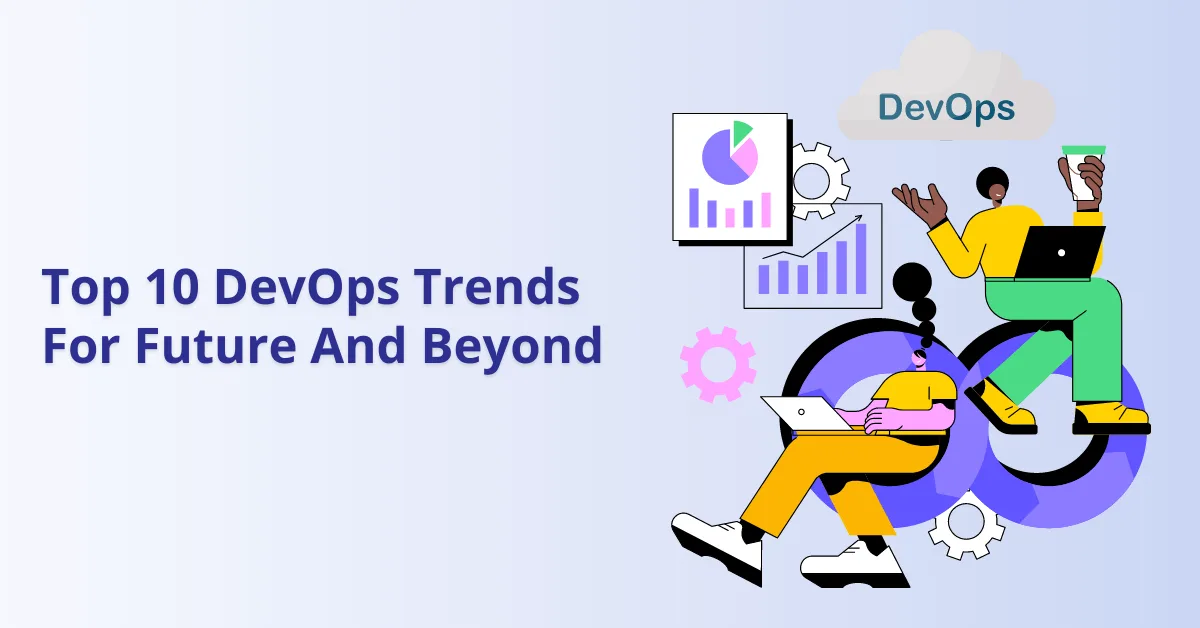Future of DevOps: Top 10 DevOps Trends For 2025 And Beyond

Reflection and understanding of the devops trends, methods, and technologies now open the doors of creativity to define new approaches to implementation. It is in this context that IT and business teams expect a peak in investment in methods, architectures, and tools that support the transition from IT tools to digital products, which have become a vector of growth for organizations. here is the complete guidance of DevOps trends For future and beyond.
For the first time in many years, people, with their ability to analyze and define new approaches focused on business value, are now the differentiator thanks to their central position. Historically, agile methods have recommended involving the business in all phases of development to ensure that the product meets expectations.
With DevOps in software development, the product is no longer an answer, it is a new way of delivering value. Highly regulated fields, such as finance, now see DevOps trends as an opportunity to provide a quality and secure service, in line with its ecosystem and meet new expectations.

The 10 Most Important DevOps Trends Predictions for Future
1. Architecture Takes Precedence Over Technology
Deploying the various components quickly while respecting all the constraints and rules requires that system architectures evolve. In this context, many components and tools are introduced in modern architectures. The Function-as-a-Service (FAAS) and Backend-as-a-Service (BaaS), are becoming increasingly popular among new architectures. These models ignore the notions of server and component and emphasize the purpose and interest of each component.
Micro-services are making a comeback in a context where the interaction between components is permanent and where failures must be isolated and where deployment must be quick and easy, without risk.
Such an approach allows people to specialize in some of these modules but also to have the possibility of deploying without impacting another component since the signature of the APIs of the micro-service is thus tested and controlled during the automatic process of being put into production.
2. Banks and Healthcare Adopt DevOps
DevOps trends in software development have often been viewed as a risk to application security, especially due to the frequent confusion between DevOps and continuous deployment. For many, CI/CD would allow developers to deploy applications in production without control. A CI/CD pipeline that is not very mature can indeed generate many negative consequences. Thus, DevOps has generally been seen as incompatible with the expected level of compliance in highly regulated areas, especially with regard to product security and stability.
These same regulations require a rapid response in the event of major incidents or security breaches. The current processes, which are far too slow, therefore do not meet this requirement. A CI/CD pipeline designed jointly with the different teams and which includes tools offering artificial intelligence allows having a level of control well beyond what is possible with traditional processes while increasing the frequency of deployments. This is how 2022 and 2024 should see the first applications in the fields of core banking or medical applications that manage confidential data.
3. Site Reliability Engineering
More and more companies are using the cloud to host their services. How do they manage their user databases around the world without having a deployment team available 24/7? In a logic of performance and in view of the technologies exploited by the giants such as Google, Netflix, and Spotify, companies are turning to site reliability engineering (SRE) to find solutions.
The principle of the SRE is to reconcile development skills and responsibilities in terms of deployment. The SRE seeks to learn from errors, by integrating the lessons of failures into its services, in the form of software improvements. Borrowed from the healthcare and aerospace industries, the techniques view breakdowns as an opportunity to learn through precise analysis of each incident.
This operational management model is interesting for companies looking to have an international reach. Organized according to the DevOps in software development model, engineering teams become responsible for the availability of their service and no longer are seen as an external deployment team.
The role of SRE and its place within a company have yet to be defined. However, one thing is certain: the SRE will be of critical importance for companies in the years to come and this is already being felt in the labor market.
4. The Adoption of Kubernetes
More and more, companies are developing their software natively with Kubernetes. In the past, Linux was the benchmark for developing open-source software; today Kubernetes becomes the flagship platform for development.
One of the drivers of this trend is the maturity of the platform’s support, whatever the type of work. This new market allows service providers and consumers to use application containers and bring them into production.
This year, there is a good chance that the entire industry will coordinate the Kubernetes server clusters and the deployment of multi-cloud solutions. Looking at the already large and growing Kubernetes community, we should also see an increase in the speed and volume of releases.
5. Service Mesh
The adoption of micro-services has many benefits for businesses. Developers use them, for example, to create portability architectures. However, there is no denying that their adoption puts a strain on DevOps teams who manage large hybrid and multi-cloud deployments. The rise of micro-services has led to a parallel boom in services mesh promising to reduce the complexity of these deployments.
A service mesh offers the possibility of observing and controlling a network of micro-services and its interactions. It provides an overview of your service and helps DevOps and SRE teams who have to meet complex operational requirements, such as A/B testing, canary rollouts, access control, and end-to authentication.
If a business is on the verge of switching from monolithic software to micro-services, it will soon cross the path of service meshes.
6. AIOps
The IT industry faces a major challenge – monitoring and responding to ever-increasing amounts of telemetry and alerts within complex and intelligent systems. Even though they may not be able to directly observe these systems, engineers and operational staff still want to know and understand what their systems are doing at all times, in case things go wrong. It then becomes essential to determine the seriousness of the incident and quickly restore service. Adopting DevOps trends & Infrastructure Management and ERS drives continuous improvement in the incident response process. That’s why there is great interest in using AI and machine learning to improve incident detection and migration time.
7. Growth of Containerized Micro-Services
Micro-services are an effective way for businesses to deliver functionality to their customers, as this approach divides a larger system into independent, loosely coupled components that can be delivered and executed using lightweight, insulating containers. The combination acts as a quick way to make changes. As organizations seek to become more agile, so too is their adoption of containerized micro-services.
This change promotes the adoption of open-source platforms such as Google’s Kubernetes.
8. Increased Focus on Continuous Delivery
Management teams increasingly recognize the correlation between key technical practices, which make up the continuous delivery of services and overall business performance, and organizational commitment. An in-depth analysis of the results of DevOps surveys shows how IT can become a driver of business performance in the future, rather than just a source of costs for the business. This change in mentality will accelerate in 2024.
9. Security and Data Protection are the New Priorities
DevOps is part of the response to the growing need for control thanks to the different concepts conveyed: an architecture favoring the isolation of the components and the data they exploit but also the automation of deployment operations with perimeter control.
To achieve the objective, the concept of security and the way of defining it must evolve. To achieve this, security teams work from the design phase of applications and deployment processes, within the team in charge of the project by favoring whitelists instead of traditional blacklists.
In parallel with organizational change, 2024 should see many mature tools that allow code scanning and intelligent testing – via artificial intelligence – whether in the developer’s environment or within CIs/CD pipelines.
10. Chaos Engineering Turns Testing Methods Upside Down
New architectures make traditional testing approaches obsolete. In response to this difficulty, chaos engineering has as a principle of software testing the failure of components, the reduction in response capacity to the shutdown of the latter itself, directly in production. It was Netflix that popularized this approach many years ago and few have tried it until then. In 2024, the use of the DevOps & Infrastructure Management approach is expected to increase. Many tools are already available on the market. This market will grow with the arrival of newcomers.

Conclusion
DevOps trends in software development will drive many changes in IT departments, whether or not they’ve initiated their transformation in previous years or not. Second, the changes will affect organizations and their approach to designing and delivering goods and services. Corporate culture will evolve to accommodate the implicit changes brought about by these changes. The employee, upgraded, becomes an asset of the organization, and not simply a set of constraints and a cost.
The different teams will review their approach, thanks to DevOps consulting services. This process of reflection will provide many answers as to the needs in terms of architecture but also on the new working methods. To set up these methods and architectures, the teams will have to work together and acquire knowledge outside their usual scope.
2024 will be the year in which DevOps and infrastructure Management implementation growth is expected to be the strongest. This growth will last through 2024 before stabilizing. Organizations that have taken the step should be able to make the most of this situation within 3 years.
As one of the top-notch DevOps Configuration Management Company, we have helped enterprises and SMEs set up processes in line with the latest trends. Contact our experts if you are seeking IT Consulting Services for your business.





